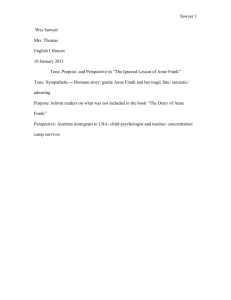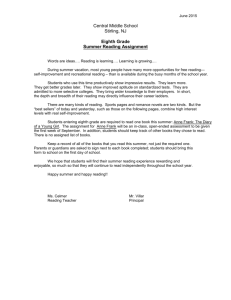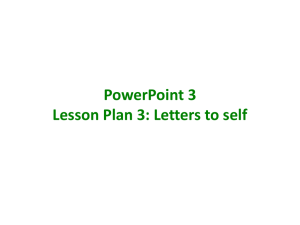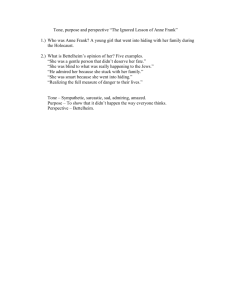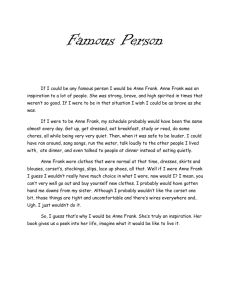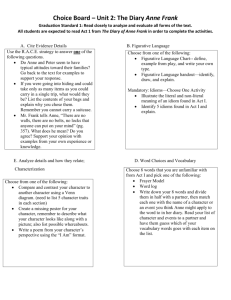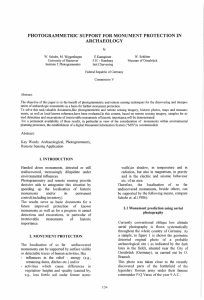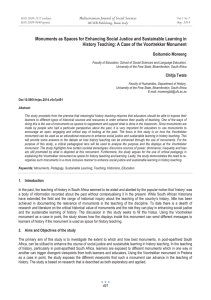PowerPoint-presentatie
advertisement
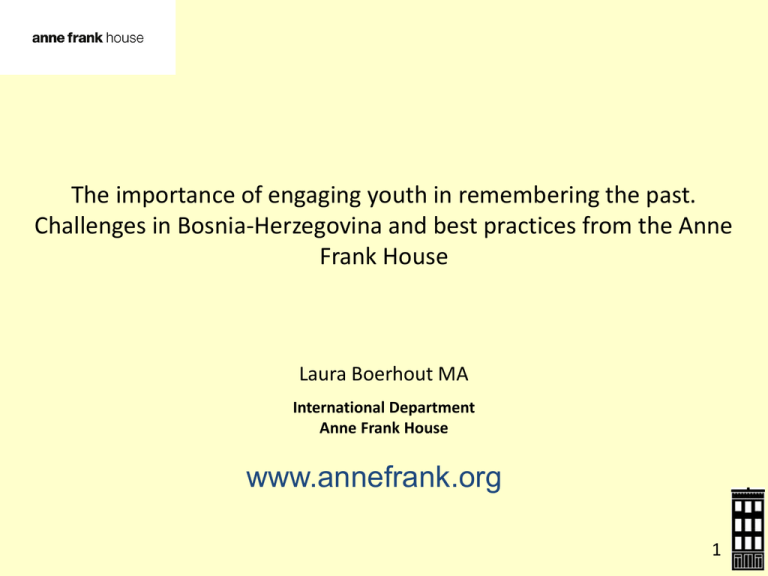
The importance of engaging youth in remembering the past. Challenges in Bosnia-Herzegovina and best practices from the Anne Frank House Laura Boerhout MA International Department Anne Frank House www.annefrank.org 1 Reflecting on remembrance o Historian Gerda Lerner: “In remembering wholly, without selective forgetting, one can fight the systems of distortions and half-truths out of which sexism, classism, racism and anti-semitism grow like poisonous weeds.” o Philosopher Georges Santayana: “Those who cannot remember the past are condemned to repeat it.” o Writer Margaret Atwood: “The past belongs to those who claim it, and are willing to explore it, and to infuse it with meaning for those who are alive today. “ 2 Overview presentation o The case of post-conflict Bosnia and Herzegovina - Historical background - Present-day socio-political climate - Public culture of remembrance - Perception of youngsters o Work of Anne Frank House o Concept Memory Walk -Films -Workshop - Follow-up - Aims and skills -Challenges and questions 3 Sarajevo – April 6th 2012 Source: Photo taken by author 4 Source:http://teaspoon-of-salt.tumblr.com/post/30505960638/fyeaheasterneurope-the-yugoslav-wars-the-very 5 Post-conflict Bosnia and Herzegovina Source: http://www.ufva.org/showcase/delegations/2011/bosnia 6 “Commemorative arena” Artists Victims and descendants Politicians Veterans Human rights activists 7 Public culture of remembrance Srebrenica July 11th Source: photos taken by author 8 My ideal monument? Perceptions of Bosnian youngsters Universalist and multi-ethnic vs. Ethnic exclusivity Source: Photo taken by author 9 Monument for “us” “I’m definitely for it. I think that every new generation needs to know what happened. Because it can happen to us again. (..) But we should never go out of this country, we need to defend ourselves if we are attacked again. We need to be careful of what’s happening. And we cannot forgive, at least for now, because somebody killed 20 or 30 people of your family. (...) I still think that we need to build monuments for future generations to remind them that it is possible to have that experience again.” Source: interview by author. 10 Monument for “all” “Maybe that’s my main attitude towards those monuments. I think they are supposed to give memory, give condolences, give something, because the history and the books and the courts are going to record what happened. (..) But not like: look what Serbs done to us? But so you can show that you are feeling sorry for what happened there. Because you have seen how far the human stupidity goes, you know. And we are like, we have to prove that in ‘90s we so failed the humanity test. So failed it.. Now we are supposed to show that we are feeling sorry for the victims, no matter who they are and what they were, because they were killed in a way that it wasn’t following the rules of war or things like that. And none of the monuments is actually showing that.” Source: Interview by author. 11 No monument at all “Maybe we should just forget it, at least a little bit, and turn ourselves to the future, towards development of the economy, towards our development of the country. And not to use every daily coffee to talk about the war and talk about the events that happened 15 years ago.” Source: Interview by author. 12 Importance of “opening up” “I’ve never heard testimony from a Serb who suffered in the war. Until now, I thought of Serbs only as war crime perpetrators. But now I can see that – as one of the detainees in this film said – there are two kinds of people, those who suffer and those who make other people suffer. I completely agree that those who make other people suffer are war crime perpetrators, regardless of their [ethnicity] or ideology.” Source: Institute of War and Peace Reporting. Mission Anne Frank House “To build up a future you have to know the past” - Otto Frank o Against racism, discrimination and anti-semitism o Promoting equal human rights, freedom and democracy o Remember – reflect – respond ! 14 ‘Anne Frank - A History for Today’ o Travelling exhibitions – worldwide o Since 1996: Over 1400 cities and 70 countries o Peer-education: empowerment and leadership 15 Innovative educational methods o Graphic novel and film o “Anne’s app for smartphone” o “Reading and Writing” 16 Free2Choose (Create) Discussing the boundaries of freedom and conflicting human rights o Freedom of speech o Freedom of religion o Freedom of the press o Right to demonstrate o Right to privacy 17 Memory Walk o Letting young people explore monuments in an engaging and creative film workshop 18 Memory Walk Berlin January 2012 Book burning memorial http://www.youtube.com/watch?v=ue9TzmhiNB0 The Missing house http://www.youtube.com/watch?v=BIZYD1UAQt8 19 Workshop o Introduction exercises o Reflection on the topic of remembrance o Monument tour o Research, filming and editing o Discussing 20 Possibilities for follow-up o Public screening o Website o Community work o Teacher training and manual o Application smartphone 21 Aims and skills o Gaining awareness, knowledge and understanding of the importance of memoralization o Reflection and critical thinking o Creativity and teamwork o Active citizenship and empowerment o Sustainable network 22 Memory Walk o Roma and Sinti monument (Berlin January 2012) http://www.youtube.com/watch?v=Dt8wVtOeJ78 o More information? Contact Laura Boerhout at l.boerhout@annefrank.nl 23
